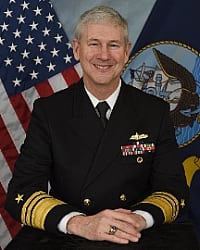SAN DIEGO— A top Navy official said the service’s future Large Surface Combatant (LSC) had its timeline pushed back for good cause and it is too early to tell if they will largely copy the FFG(X) future frigate’s procurement process.
Speaking here at the 2020 annual AFCEA West conference on Tuesday, Vice Adm. Thomas Moore, Commander of Naval Sea Systems Command (NAVSEA), was asked if the new FFG(X) requirements process had limitations after the Navy’s FY 2021 budget request moved back both the LSC and the Common Hull Auxiliary Multimission Platform (CHAMP).

“I don’t think there’s a limitation to the process, I think the process is right. I think the key is – back to the requirements is – what is it exactly that you want? And then getting the realistic cost of what that is. And those two tend to collide often. So I’ve watched the Large Surface Combatant with great interest over the last four years and frankly I think we’ve pushed it to the right for good reasons,” Moore said.
“We think [Arleigh Burke
-class destroyer DDG-51] Flight 3 meets the needs. I think the threat’s evolving, we’re looking at unmanned so we don’t want to rush into this,” he continued.
Moore noted in the first draft of LSC it “was going to be pretty expensive” and since the Secretary of the Navy and Chief of Naval Operations are talking about distributed maritime operations and a high-low force structure mix, the service is asking “does everything have to be a high-end process?”
In January, Director of Surface Warfare (N96) Rear Adm. Gene Black said the LSC was being pushed back to the late 2020s after original hopes to get it on contract by 2023.
“I think we will probably buy our first Large Surface Combatant in the late 2020s. After Flight III DDG reaches IOC, after more Flight III procurements, and after we’ve matured some new technologies to the right level,” Black said at the Surface Navy Association symposium (Defense Daily, Jan. 15)
“We’re trying to do it in a very measured manner so that we minimize the risk as we go forward,” Black added.
The Navy’s FY 2020 budget request planned for the first LSC to be procured in the mid-2020s, conducting a preliminary design phase starting in FY 2020 and the first vessel bought as early as 2025 (Defense Daily, March 19, 2019).
The Navy plans for LSC to have the Aegis Baseline 10 combat system, SPY-6 radar, and use integrated power systems.
Moore said he thinks the requirements evaluation team process used for the frigate works and bringing industry into the process early “is the best way to do it.”
However, “you’re going to have to have some cost realism in there up front” with the Navy needing to explain what it is unwilling to spend up to for certain capabilities.
“Those two often collide too late in the game in my opinion. So I think the process is fine. I think we’ve got to continue to fine tune it. And I think frigate is a great example where it’s going to work and we’re going to go learn from that going forward,” Moore said.
Moore was unwilling to say if the LSC would mostly copy the FFG(X) requirements process, opting to see how it works out first.
He reaffirmed the Navy likes the process it is using with FFG(X) and expects to bring a lot over into the Large Surface Combatant. However, “I think we’re going to see when we downselect here and start building the ship, we’re going to learn did we get it exactly the way we want to.”
“Are we going to follow the same process on Large Surface Combatant? I think that remains to be seen. What I think is we’re going to go see how the FFG(X) comes out and we’re going to go. I think we like the process we use…there’s a lot to like about the process” for LSC, he added.
“So I don’t want to commit that we’re going to be using the exact same process for the Large Surface Combatant. It’s hard to imagine that we’re going to come up with a completely new process. I think the way we’ve done it here is a model for how we’d like to come in moving forward on the shipbuilding side of the house to reduce risk and get a platform to the fleet faster.”